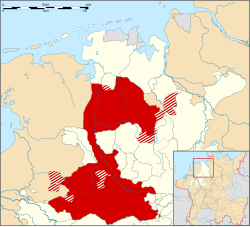Prince-Bishop of Munster
| Prince-Bishopric of Münster | ||||||||||||||||
| Hochstift Münster | ||||||||||||||||
| State of the Holy Roman Empire | ||||||||||||||||
|
||||||||||||||||
|
||||||||||||||||
|
Map of part of the Lower Rhenish–Westphalian Circle in
1560, Prince-Bishopric of Münster highlighted in red |
||||||||||||||||
| Capital | Münster in Westphalia | |||||||||||||||
| Languages | Low Saxon, German, Frisian | |||||||||||||||
| Religion | Roman Catholic; Lutheran; Anabaptist | |||||||||||||||
| Government | Elective principality | |||||||||||||||
| Historical era | Middle Ages | |||||||||||||||
| • | Created on collapse of Saxony |
1180 | ||||||||||||||
| • | Secularised to Prussia | 1802 | ||||||||||||||
|
||||||||||||||||
The Bishopric of Münster was an ecclesiastical principality in the Holy Roman Empire, located in the northern part of today's North Rhine-Westphalia and western Lower Saxony. From the sixteenth to the eighteenth centuries, it was often held in personal union with one or more of the nearby ecclesiastical principalities of Cologne, Paderborn, Osnabrück, Hildesheim, and Liège.
Münster was bordered by the United Provinces to the west, by Cleves, Vest Recklinghausen, and Mark in the south, Paderborn and Osnabrück in the east. In the north and north-east it bordered East Frisia, Oldenburg and the Electorate of Hanover (est. 1692).
As with all the other prince-bishoprics of the Holy Roman Empire, it is important to distinguish between the Prince-Bishopric of Münster and the Diocese of Münster although both entities were ruled by the same individual. The dioceses were generally larger than the corresponding prince-bishoprics and in the parts that extended beyond the prince-bishopric, the prince-bishop's authority was strictly that of an ordinary bishop and limited to spiritual matters.
The Diocese of Münster was founded by Charlemagne towards the end of the Saxon War about 795, as a suffragan of Cologne.
...
Wikipedia



